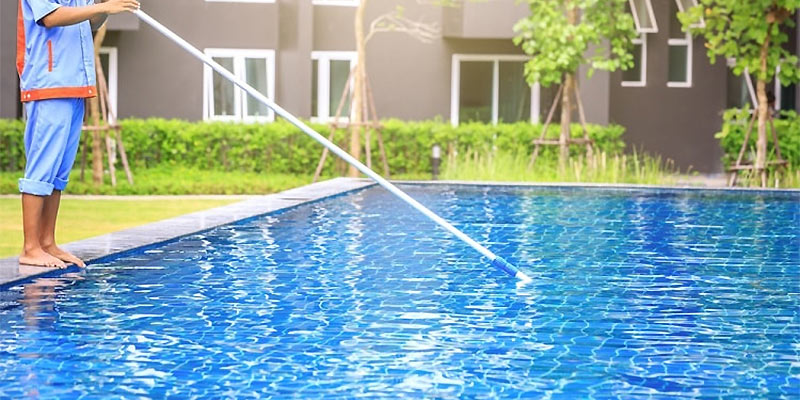
Every pool owner wants the same thing – sparkling blue water. Having a swimming pool that’s not properly taken care of can lead to all kinds of health issues – some of which can be very serious indeed. Most pool owners outsource the cleaning job to professionals, but you don’t really have to if you learn how to clean it yourself. Below, we’ve put together a guide to keeping your pool healthy for swimmers.
Swimming pool cleaning steps:
1. Skimming
Skimming prevents debris from sinking to the bottom of your swimming pool, so it’s best to get rid of it before it starts. This will also leave you with less debris to vacuum. For this, you will need either a flat skimmer or a bag skimmer. However, the flat skimmer is better because it’s easier to shake off the debris you’ve collected from the pool. You will need a leaf rake to skim beyond the water surface and collect debris on corners or steps.
2. Vacuuming
A lot of debris and bacteria builds on the bottom of a pool. You should vacuum your pool once each week to keep it safe for use. You use pool vacuums much the same way you would vacuum a carpet. Move the vacuum across the bottom of the pool, staying longer in areas that need appear dirtier.
Some automatic cleaners do not require you to vacuum yourself. There are 3 types of automatic pool cleaners you can choose from: suction-side, pressure-side, and robotic. A robotic pool cleaner runs on electricity, so your filter does not have to be running while it’s cleaning. And it uses the power of suction (rather than water pressure) to clean up dirt and debris on the bottom of the pool.
3.0Cleaning the Walls
Brushing the walls at least once each week eliminates everything from algae buildup to calcium scale before they become serious problems. To clean the walls, use a nylon or polybristle brush and move the dirt towards the drain. Start with the walls on the shallow end, and work your way to the deep end in long, sweeping strokes.
Make sure to get into every corner and on each stair. The hard-to-reach places may be the most important areas to scrub because they get very little circulation. You can purchase brushes in different widths that attach to the end of a telescopic pole, or a brush that comes complete with a pole already attached. Pool brushes can also be used to clean your deck and patio.
4. Backwashing the Pool Filter
How you backwashing the pool filter varies depending on which type you have, but each one requires periodic cleaning. If your filter isn’t cleaned regularly, it won’t trap the debris. The flow of your water will also change, signaled by an increase in the pressure gauge and flow meter.
Your pool filter comes in one of three different types: cartridges, sand or diatomaceous earth (DE).
- In the sand filter, sand blocks oil and dirt; while the backwash directs dirty water to a storm drain or the ground. Sand filters need to be cleaned once each season with a filter cleaner.
- In a DE filter, clay-like remains of marine organisms undertake the filtering with the backwash directing the dirt to a filter bag (needs to be emptied every other week). Replenish your DE filter by sprinkling it to the skimmer well. To cut oil build-up, the DE filter grids need to be cleaned once each season with the filter cleaner.
- A cartridge filter consists of a removable unit that can be hosed off and reinserted. When cleaning, remove the cartridge from the pool filter and hose off any loose dirt or debris. Next soak the filter element(s) in filter cleaner for around 12 hours. After soaking, rinse them thoroughly using fresh water.
5. Checking the baskets
Make sure there isn’t any hair, leaves, or wildlife caught in the basket. Pump baskets usually come with a clear lid so you can easily check the flow or if the basket is full. Wear rubber gloves; you may be surprised by what you find.
6. Managing Chemicals
It is important to test and maintain the pH and chlorine level of the pool water. Untreated water allows algae and can make you ill. There are several pool test kits that tell your pH and chlorine levels. Follow the instructions on the kits to conduct the tests. Your pH should be between 7.2 and 7.6 and chlorine should fall between 1.0 and 2.0 ppm (parts per million). If your water falls outside the appropriate range, add the needed chemicals to correct the imbalance.
7. Shocking
Shocking involves adding a large dose of chlorine to the pool to eliminate algae and other contaminants. The amount of shock you use varies based on the specific chlorine product and the amount of water in the pool; follow the manufacturer’s instructions.
There are liquid chlorines, powdered chlorines and chlorine tablets. The tablets make it easy to add chlorine to your pool. Simply drop the tablet into the dispenser, put the lid on and let it float in the pool. For the other chlorines, follow the instructions on their packages.
Keeping your pool fresh and clean does not demand intensive labor, but it requires steady commitment. Expect to spend anywhere between four and eight hours each week—a small outlay compared to the amount of time you will spend enjoying your pool.
